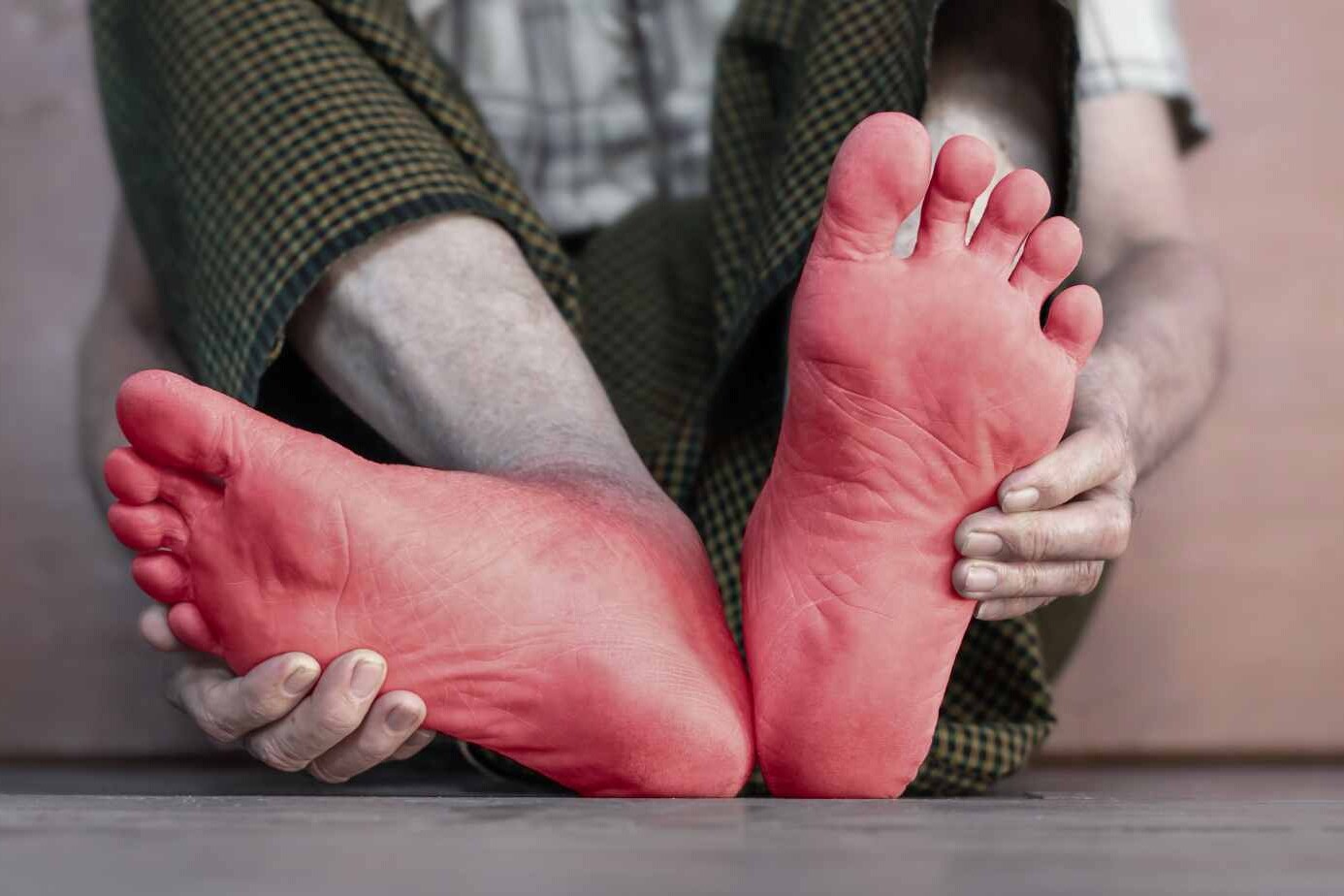Diabetic neuropathy is a severe problem of diabetes. It can lead to nerve damage. This causes pain, numbness, and loss of feeling, especially in the feet and legs. Treating it well involves keeping blood sugar normal, managing pain, and avoiding more problems. This guide will look at ways to treat diabetic nerve damage. It aims to help those with diabetic neuropathy feel better and improve life quality.
Living with diabetic nerve pain is hard, but we are here to help. We provide the information and support you need to handle this problem. Working closely with your healthcare team and finding the best treatment for diabetic peripheral neuropathy is crucial. This way, you can manage your health and work towards a more comfortable life.
Table of Contents
ToggleUnderstanding Diabetic Neuropathy
Diabetic neuropathy is a common problem for those with type 1 or type 2 diabetes. Up to 26% of people with type 2 diabetes might have it when they find out. It usually starts with symptoms like pain, tingling, and numbness in the toes and feet.
Symptoms and Diagnosis
Doctors can spot diabetic neuropathy with a checkup and some tests. They look at the patient’s symptoms, which might be pain, tingling, or loss of feeling in the feet and toes.
Risk Factors and Complications
Bad blood sugar control, high blood pressure, and being overweight can up the chances of getting neuropathy. If not treated, it can cause foot ulcers, infections, and maybe even the loss of a limb.
Managing Blood Sugar Levels
Maintaining tight control of blood sugar levels is key in managing diabetic neuropathy. This helps prevent further nerve damage. The ADA suggests aiming for blood glucose levels between 80-130 mg/dL before meals and under 180 mg/dL after meals.
Your A1C should be 7% or lower. This is important for most people with diabetes to prevent nerve damage.
Importance of Glycemic Control
It’s crucial to reach and keep optimal blood sugar levels. This is shown by A1C tests. For those with diabetes and neuropathy, high A1C levels mean more risk of nerve damage.
Focusing on blood sugar control can help slow down nerve damage. It might also make current symptoms better.
Dietary and Lifestyle Modifications
Besides medicine, what you eat and how active you are matters. A healthy diet and exercise can really help. Try to eat foods that are good for you and do not raise your blood sugar quickly.
Do activities like walking or swimming. This can help your body use insulin better. It’s good for your health in many ways.
Working hard to manage blood sugar well is key for people with diabetes. Doing this lowers the impact of neuropathy. It also leads to better health in the long run.
what is the best treatment for diabetic neuropathy
Diabetic neuropathy has no cure. But, there are ways to manage its symptoms and prevent more nerve damage. Medications like pregabalin and gabapentin can reduce nerve pain. Antidepressants and even opioids help too.
Prescription Medications
Prescription drugs are key in managing diabetic neuropathy. Medicines like pregabalin and gabapentin help lessen nerve pain. Antidepressants, including duloxetine, are also effective in treating the pain.
Alternative Therapies
Many people get relief from alternative treatments. These can be topical creams with capsaicin or supplements like alpha-lipoic acid. Other methods include TENS, acupuncture, and acetyl-L-carnitine. Although more research is needed, users often say these methods help.
So, treating diabetic neuropathy often combines medicines, lifestyle changes, and alternative therapies. It’s important to work with your doctor to find the best solution. They can guide you on effective drugs and see if alternative treatments help.

Pain Management Strategies
Dealing with severe pain from diabetic neuropathy is crucial. We look into many ways to manage this pain better. We aim to boost our life’s quality and how well we function each day.
Over-the-Counter Remedies
Mild to moderate nerve pain can sometimes lessen with basic medications. These include acetaminophen, ibuprofen, and creams with lidocaine. They might be a good option when starting to deal with diabetic nerve pain.
Prescription Pain Relievers
If the pain is severe or constantly there, you might need stronger help. Doctors might recommend drugs like antidepressants or anticonvulsants. Sometimes, opioids can also be an option. These stronger medications can target the pain from diabetic peripheral neuropathy.
Interventional Treatments
For more challenging cases, interventional options might be on the table. These include nerve blocks, spinal cord stimulation, or surgery to release nerve pressure. These advanced methods offer specific help for those facing hard-to-treat pain.

Conclusion
Diabetic neuropathy is a complex condition. It needs a lot of different treatments. By keeping blood sugar levels under control, managing pain, and stopping complications, people can feel better. They can improve how they live.
This guide talks about many treatment choices. These include medicine, alternative therapies, and treatments like surgeries. While diabetic neuropathy can’t be cured, the right treatments can help a lot.
Working with your healthcare team is key. Together, you can make a plan that fits you. This can include many treatments to help your specific needs.
Using the advice in this guide can make a big difference. It can help people with diabetic neuropathy better manage their health. They can lessen their symptoms. And they can enjoy a better quality of life.
This guide is key for anyone dealing with diabetic nerve damage. It gives a good overview of treatment options. And it’s a great help for managing diabetic neuropathy well.
FAQ
What is diabetic neuropathy and how is it treated?
Diabetic neuropathy is a serious issue with diabetes. It causes nerve damage. This leads to pain, numbness, and sometimes not feeling your feet or legs. To treat it, you must control your blood sugar. You also need to manage pain and stop further problems.
What are the symptoms and risk factors of diabetic neuropathy?
The main type affects many nerves, leading to different symptoms in the toes and feet. These include pain, tingling, and sometimes not feeling anything. The risks are due to bad control of sugar, high blood pressure, and obesity. Smoking is also a big risk.
How important is maintaining blood sugar control for managing diabetic neuropathy?
It’s very important to keep your blood sugar in check. This is key to slowing down or preventing more nerve damage. Good sugar control can even make symptoms better for some people.
What are the treatment options for diabetic neuropathy?
Several options are available. These include drugs like anticonvulsants and antidepressants. There are also alternatives like capsaicin cream and acupuncture. The best treatment combines drugs, lifestyle changes, and what suits the person best.
How can the pain associated with diabetic neuropathy be managed?
Dealing with the severe pain is crucial. You can use over-the-counter drugs, prescriptions, or methods that target the nerves. These include nerve blocks or spinal cord treatments. They aim to make life better and improve daily tasks.
Source Links
About The Author

This article is medically reviewed by Dr. Chandril Chugh, Board-Certified Neurologist, providing expert insights and reliable health information.
Dr. Chandril Chugh is a U.S.-trained neurologist with over a decade of experience. Known for his compassionate care, he specializes in treating neurological conditions such as migraines, epilepsy, and Parkinson’s disease. Dr. Chugh is highly regarded for his patient-centered approach and dedication to providing personalized care.
→ Book a consultation to discover which remedies suit your needs best.




